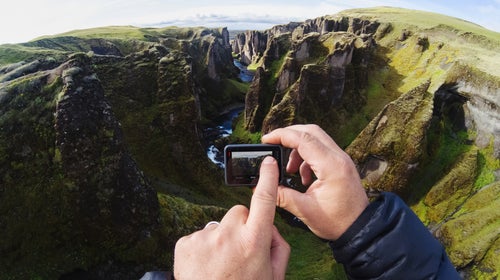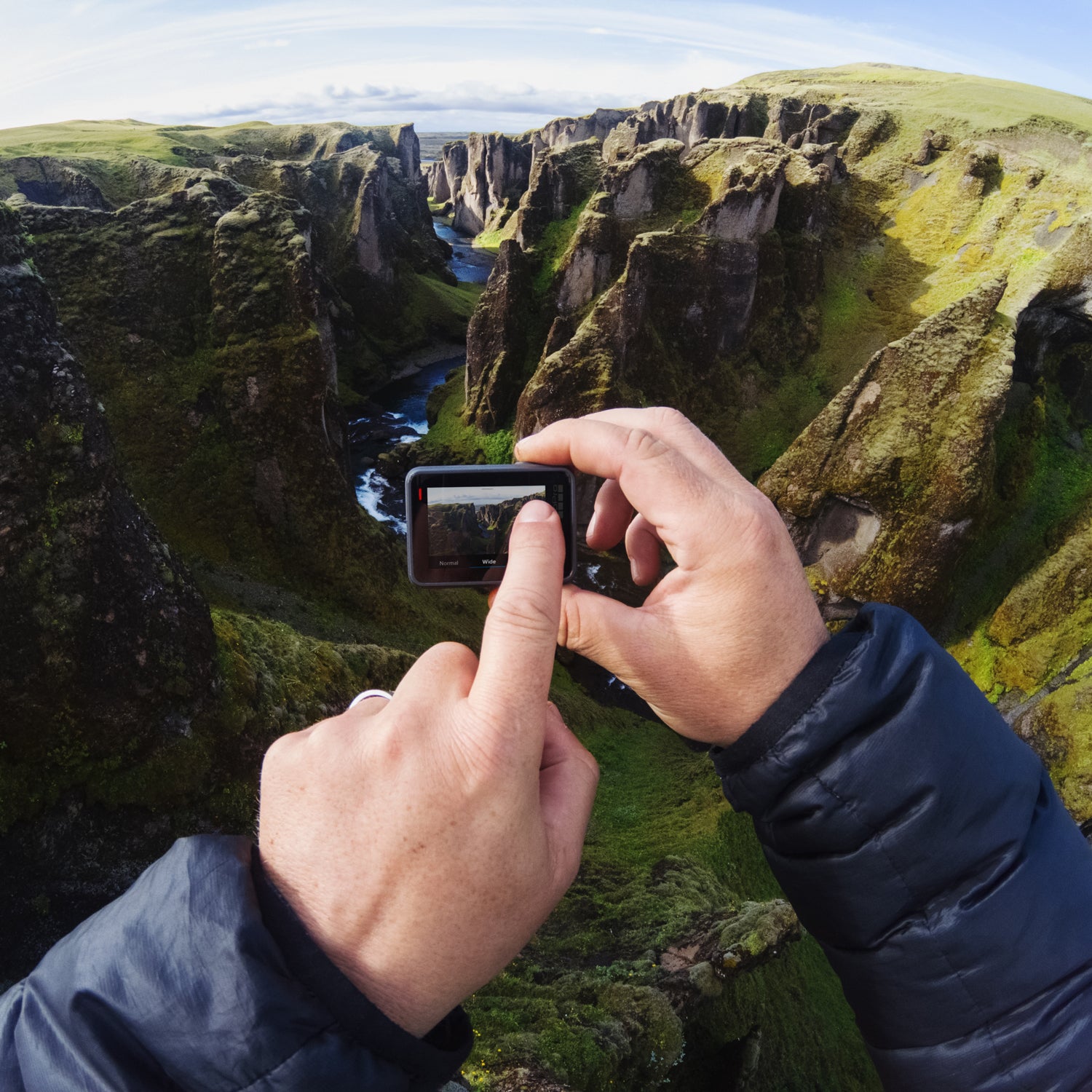GoPro launched its newest flagship camera, the Hero6, in September with some important new features that make it a smart upgrade for anyone who frequently shoots action-cam footage.
The most notable item is the improved in-camera stabilization, which eliminates the need for a gimbal. GoPro also made some notable resolution changes: the Hero6 (unlike the Hero5) shoots 4K footage at 60 frames per second, and 1080p footage at a super slow 240 frames per second. Finally, thanks to a stronger Wi-Fi signal, the Hero6 has better app integration and works with the new QuikStories feature, which edits footage for you.
I got my hands on one of the cameras when it launched and have been testing it ever since. I’ve taken it mountain biking, go-karting, and on a four-day backpacking trip. I’ve also been playing with it at home. Overall I’ve been very impressed with the leaps GoPro made between the 5 and the 6. Here’s why.
Internal Stabilization
The improved image stabilization, in my mind, is the Hero6’s biggest, most exciting upgrade, allowing for buttery smooth footage with no additional equipment—like, say, a gimbal—required.
In the past, I had to mount my GoPro on a stabilizer, like the brand’s Karma Grip, to reduce shake while filming. With the 6, however, I simply activate the internal image stabilization feature on the touchscreen menu and voila—I can capture a mountain-bike ride without wanting to vomit when I watch.
Yes, the Hero5 had internal stabilization as well, but it was two-axis. Similarly, the stabilization only worked when you shot in narrow or medium field of view (which refers to how wide a shot the camera is set up to take). The Hero6, in contrast, has three-axis stabilization that’s available across a greater range of resolutions and frames (like 4K 30 and 1080p 120), including in wide field of view.
Is the Hero6 stabilization equal to professional Absolutely not. But it’s a major improvement over the Hero5 and goes a long way toward helping you create more professional-looking videos.
To test the stabilization, I grabbed a Hero4 Black, which doesn’t have any stabilization, and put it up against the Hero6 Black with the stabilization turned on. I took both on a bike ride around a local trail system near our headquarters in Santa Fe. Both cameras were mounted to my handlebars and were recording in 1080p at 60 frames per second in Superview mode, which gives you the widest field of view and is great for POV.
https://youtube.com/watch?v=fakSbn2u-k8%3Frel%3D0
Here’s another mountain-biking clip from a different ride. This was shot in 2.7K at 60 frames per second with internal stabilization turned on. (The 2.7K 60 option is one of my favorites, because you get a higher resolution than HD and a fast frame rate for action but you can still take advantage of internal stabilization.)
https://youtube.com/watch?v=QRgrWptzQgc%3Frel%3D0
Finally, here’s a clip shot in 4K at 30 frames per second with stabilization on (unfortunately, you can’t get stabilization in 4K 60 fps). I’m chasing my friend on foot while he pedals up a trail.
https://youtube.com/watch?v=yyKbMlorZYk%3Frel%3D0
Slow-Mo Footage
OK, so stabilization is the key update, but I was also excited about improvements like the 1080p video at 240 frames per second, which creates ultra slow-motion footage that’s great for capturing action sports.
The iPhone 8 can shoot this same kind of slow-mo, but the GoPro still has a mobility advantage: it’s way easier to strap to your bike, your ski helmet, or your dog. Also, I worry less about my durable $500 GoPro than my fragile $1,000 iPhone.
Here’s a clip of my dogs running around the backyard at 240 frames per second:
https://youtube.com/watch?v=2u3gfkg5U-Y%3Frel%3D0
And here’s a clip of my buddy fly-fishing, plus a campfire shot at 1080p 240:
https://youtube.com/watch?v=WyG1NJRagPo%3Frel%3D0
That said, you’ll need to use the 240 frames per second feature sparingly, since it’s meant to capture action.
I found myself shooting more often in 2.7K 120 because I like the higher resolution, and because 120 frames per second is plenty slow. I’ll also use the 1080p 120 mode, because it allows for internal stabilization (unlike 1080p 240 or 2.7K 120). Here’s an example of 1080p 120 with stabilization on:
https://youtube.com/watch?v=-12RnvJD3dE%3Frel%3D0
High-Res 60 fps Footage
For video nerds like me, that faster frame rate is indeed a big upgrade, because it’s better for capturing action at a high resolution. But it’s actually too much for most people most of the time—the data files are too big.
If you send clips from the Hero6 to your phone, then upload them to Instagram or Facebook, those clips are going to get compressed to a lower-resolution 720p or 1080p. If you plan to edit your footage in something like Premiere Pro or Final Cut, then yes, 4K footage downsized to 1080p will look really nice. But how many people are going to notice that on Instagram? More importantly for most users, shooting in 4K eats up storage space on your memory card and computer a lot quicker than shooting in 1080p.
During the Hero6 Launch in San Francisco, we raced go-karts and then rode e-bikes across the city. I asked a GoPro tech what his preferred shooting mode was for the day’s activities. He told me 1080p at 60 frames per second in Superview with stabilization enabled was his go-to setting for just about everything. He likes that setup because it looks great, plays nice with your phone, and it helps the battery last longer. (The Hero6 is rated for 70 minutes of use at 4K 60 versus 100 minutes at 1080p 60.)
Just for reference, here are a couple clips shot in 4K 60:
https://youtube.com/watch?v=ZIpYJbw6s8Q%3Frel%3D0
Those clips look great, but the overall lesson here is that you’ll need to choose the right resolution, frame rate, and view for each situation. It you’re only shooting for Instagram, stay away from 4K. If you’re shooting for a real film, go for it. It can be tricky to always choose the right combo, but thankfully GoPro has for getting the most out of your camera based on what you’re shooting.
The GoPro App
The power of your GoPro expands when paired with the app, and that integration just got a lot better.
First, it’s much easier to pair your Hero6 with the app, thanks to a proprietary new processor that makes the Wi-Fi signal three times faster. The pairing process isn’t seamless—I still had some issues, and the app froze occasionally—but it’s noticeably better than before.
The other big development is something called QuikStories. It’s an in-app editing program that automatically uses face detection, GPS, and audio to identify the best clips, then complies those clips into an edit.
As a professional video editor, I was skeptical about QuickStories. But having seen it work, I’m impressed. It catches a good chunk of what I would consider to be the highlights, then cuts them together in a concise edit that’s easy to watch and set over an audio track of your choosing. You don’t have to spend any time editing if you don’t want to.
But it’s not perfect, and often misses key scenes. To help the editing feature along, you can do things like shoot shorter clips (so it can scan more quickly), and highlight clips you think are important. (You can do that using the camera’s voice control by saying “GoPro Highlight.”)
Here's an example of what it can do with very little help from the shooter:
https://youtube.com/watch?v=E0micKqtAiM
Voice Control
GoPro introduced voice control with the Hero5, but it gets better with the Hero6. Being able to stop and start recording, switch between photo and video modes, and turn the camera on and off without ever touching it is incredibly useful when you’re skiing or mountain biking and need to focus on the task at hand.
Photos
The Hero6 is first and foremost a video camera, but it shoots nice stills, too.The camera is the same one that’s in the 5, and it produces 12 megapixel JPEG or RAW files.
Is the camera better than what’s in the new iPhones? Nope. But again, the GoPro is great for getting angles that your phone struggles to capture, courtesy of all the different places you can mount it.
Should You Upgrade?
I’ve used the Hero4 Black and Silver models extensively since their launch in 2014 and never really felt the need to upgrade to the Hero5, whose biggest upgrades were caseless waterproofing, voice control, and two-axis stabilization. None of those features added up to a remarkably better camera, in my mind.
With the Hero6, however, I get the best of the Hero5 plus that upgraded stabilization, higher-quality footage, and better app integration. It’s become a no-brainer upgrade for anyone with a Hero4. If you have the Hero5, you’ll still benefit from the smoother, higher-quality video, plus an easier-to-use app.
One last note: if you’re saving your money to buy a POV camera, you should also consider the new Fusion, GoPro’s 360-degree camera that ships in December. I’m not a huge fan of 360-degree footage, but I’m excited to see how a feature called will work. It’s rumored to let you shoot full, spherical video then, after the fact, you can pick an angle and play it back like a normal, fixed-perspective POV video.


